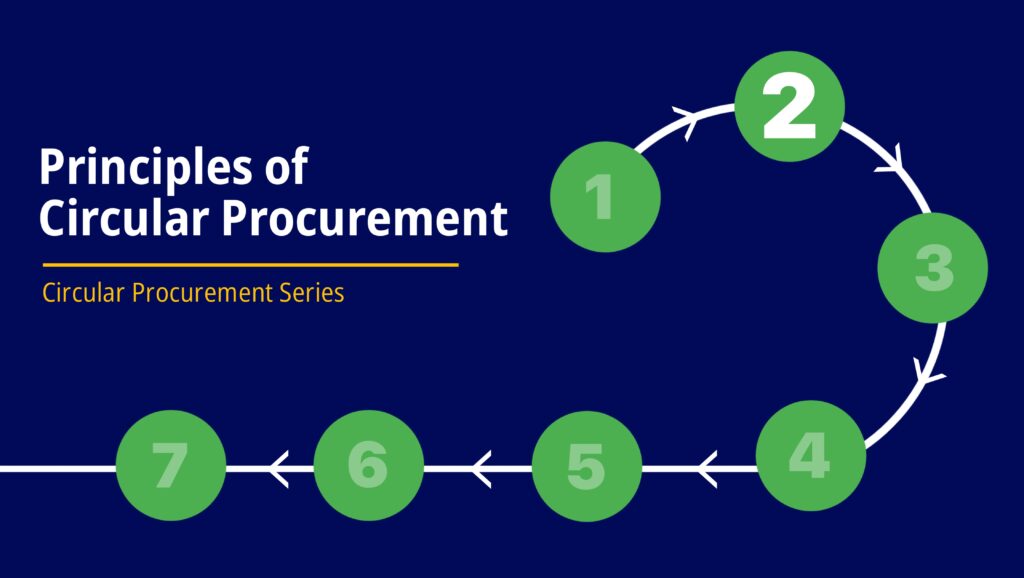Principles of Circular Procurement

The concept of Circular Procurement is not limited to purchasing goods and services with a plan for end of life only. It also includes reconsidering the need to purchase at all. One can also consider purchasing refurbished products, products made from recycled materials, considering product as a service as well as reusing and repairing materials all to transit from the linear economy to circular economy. Both Circular Procurement and circular economy share the same key principles which are to eliminate waste,circulate products and materials and regenerate Nature.
To put to practise these key principles, individuals and organisations must consider their source for raw materials or procurement and measure the durability, repairability and recyclability of products.
Sourcing or Procurement
Individuals and organisations can directly source raw materials or contract suppliers for raw materials as well as finished goods . However, the overriding aim should be to procure materials or finished products that aligns with a Circular Economy model.
When outsourcing Items and services from Circular Suppliers , Priority can be given to products that fall under any of the categories: Eco-designed, Bio-sourced, Eco-innovative, Recycled and Recyclable materials. An example is the Lagos State Environmental Protection Agency’s implementation of the e-waste policy with green procurement (purchases with minimal environmental impact and products made from more sustainable materials) being one of the programmatic areas of the policy for new and used equipment.
Though this is for the electronic sector, green procurement policies can be adopted to guide businesses and individuals when acquiring materials, supplies and services as this puts a consciousness of the immediate and long term impacts of what is procured on the environment and human health in the minds of buyers. Lush Retail Ltd, a British cosmetics company, redesigned its packaging to reduce plastic use by making their cosmetic products as ‘naked’ products (liquid to solid).
Currently, about 65% of their product range is naked and they have been able to design out over 150 million shampoo plastics. Apple as a brand in 2022, released the details on the increased use of recycled materials to make their products. Not only, they provided the means of collecting back old phones through their apple stores which is a progress in their recycling innovation effort.
Durability, Reparability and Recyclability of Products
To transition from a linear procurement system to a Circular Procurement system, the principle of durability, reparability and recyclability of products must be considered . In Circular Procurement, products with the capability to be reused at the end of life to reduce waste, pollution and refrain manufacturers from tapping into virgin materials are priority .
In recent times, beverage companies with packaging materials that are not fit for recycling (such as dark coloured plastic packaging materials) have made their packaging materials transparent which is easily recycled compared to the dark coloured plastics. A Dutch company, Gerrard Street Headphones, designs their products without glue to be easily disassembled, repaired and recycled. These products are sold as services as headphones are purchased on subscription which means that the company retains the ownership and responsibility for the product for its lifetime. A customer can call in to get faulty parts of the headphones replaced or send back the product to the manufacturer for an upgrade or replacement of headphone models.
In an African context, these principles can be gradually adopted, explored and integrated into the procurement structure of businesses and individuals as there is really no one way around circular procurement.
References
- https://www.linkedin.com/advice/0/how-do-you-apply-circular-economy-your
- https://www.manutan.com/blog/en/glossary/circular-procurement-definition
- https://greenbusinessbureau.com/blog/what-is-a-green-procurement-policy/
- https://procurementtactics.com/green-procurement-practices/
- https://www.apple.com/ng/newsroom/2022/04/apple-expands-the-use-of-recycled-materials-across-its-products/
- https://www.ellenmacarthurfoundation.org/articles/circular-economy-products



